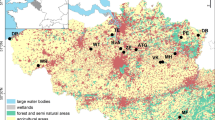Summary
The Quaternary sedimentation in The Netherlands is mainly controlled by two factors: a. world-wide climatic fluctuations; b. continuous subsidence with consequent block faulting.
The climatic changes caused changes in sea level. As a consequence the transition belt between marine and fluvial sedimentation shifted regularly. These climatic fluctuations also influenced the fluvial regimen and once, during the Saalian glaciation, the country was partly covered by the Scandinavian inland ice.
On the other hand a number of observations point to tectonics as an important agent in the evolution of the sedimentary succession in The Netherlands. As a result the landscape is composed of a rather complex system of lithologic patterns. Therefore the geological mapping of these patterns in units can only serve for engineering technical purposes when dealing with the genetic aspects of these units in detail.
The surface layers in the Netherlands consist almost exclusively of Quaternary deposits. Only in the eastern part, along the German frontier, and in southern Limburg, there are small areas of outcropping Palaeozoic, Mesozoic and Tertiary rocks (fig. 1). This paper deals with the Quaternary deposits which mainly are of marine, fluvial and periglacial origin. In the northern part of the country glacial deposits are locally important. Vast Holocene peat deposits are present in the western and northern part of the Netherlands.
Résumé
La sédimentation du Quaternaire aux Pays-Bas était gouvernée en grande partie par deux facteurs: a. des fluctuations climatiques modiales; b. des affaissements continuels et les blocs faillés qui en résultent.
Les changements climatiques provoquaient des changements du niveau de la mer et en conséquence la zone de transition entre les sédiments marins et les sédiments fluvials se déplaçait régulièrement. Ces fluctuations climatiques influaient également sur le régime fluvial et une fois le pays était partiellement couvert par l’inlandsis nord-européen (glaciation Saalienne). De l’autre côté il y a un certain nombre d’observations qui font ressortir des phénomènes tectoniques en tant qu’un facteur important quant à l’évolution de la succession sédimentaire. Le résultat de ces faits c’est un paysage d’un système assez complexe de modèles lithologiques. C’est pour quoi que la cartographie géologique de ces modèles en unités ne pourra servir pour des buts techniques qu’en traitant les aspects de la genèse de ces unités en détail.
Les gisements supérieurs consistent à peu près exclusivement en dépôts quaternaires. Seulement dans la partie oriental, le long de la frontière allemande, et au Limbourg du Sud il y a de petits territoires de roches paléozoiques, mésozoiques et tertiaires aux lignes d’affleurement (fig. 1). La contribution traite les dépôts quaternaires qui en grande partie sont de l’origine marine, fluviale et périglaciaire. Vers le nord on trouve des dépôts glaciaires, par endroits importants. Dans les régions occidentales et septentrionales il y a de vastes dépôts de tourbe holocène.
Similar content being viewed by others
References
BISSCHOPS J.H. (1973): Geologische Kaart van Nederland, 1:50,000 met toelichtingen. Blad Eindhoven Oost. — Rijks Geologische Dienst, Haarlem, 132 pp.
HAGEMAN B.P. (1969): The western part of the Netherlands during the Holocene. — Geol. en Mijnb. 48, 373–388.
ter WEE M.W. (1966): Geologische Kaart van Nederland, 1:50.000 met toelichtingen. Blad Steenwijk Oost (160). — Rijks Geologische Dienst, Haarlem, 106 pp.
Author information
Authors and Affiliations
Rights and permissions
About this article
Cite this article
Bisschops, J.H. Natural material selection according to geological patterns in the pleistocene and holocene landscape of the netherlands. Bulletin of the International Association of Engineering Geology 10, 15–18 (1974). https://doi.org/10.1007/BF02634624
Issue Date:
DOI: https://doi.org/10.1007/BF02634624



